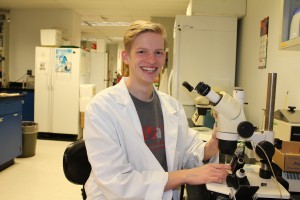We are happy to continue our research investigating the role of the survival motor neuron (SMN) protein in motoneuron development. In this grant we will investigate the interaction between SMN and RNA binding proteins.
Below is a summary of studies. Interested OSU graduate students contact me to discuss the possibility of working in our lab.
Project Summary
Understanding the mechanistic basis of motoneuron dysfunction and its role in motoneuron diseases would fill a major gap in neuroscience and advance new approaches for treating devastating diseases such as amyotrophic lateral sclerosis (ALS), hereditary motor neuropathy and spinal muscular atrophy (SMA). These diseases afflict over one hundred thousand adults, infants, and children per year in the US. ALS and SMA are particularly devastating diseases resulting in paralysis and death often within a few years of diagnosis. The genetics of these diseases indicates that motoneurons are particularly vulnerable to defects in proteins tasked with critical RNA processing functions. However, exactly why motoneurons are vulnerable to RNA processing defects is not understood. The scientific rationale for this project is to elucidate mechanistically how mishanding of RNAs can disrupt motoneuron function and lead to motoneuron death. Elucidating the motoneuron-specific RNA processing defects caused by these mutations is essential for understanding motoneurons in both normal and diseased conditions and will direct critically needed therapeutics. To tackle this issue, we focus on the ubiquitously expressed survival motor neuron (SMN) protein and the motoneuron disease SMA. SMA is a motoneuron disease that affects infants/children and is caused by low survival motor neuron (SMN) protein levels. SMN functions in many aspects of RNA metabolism. However, the critical RNA handling function of SMN in motoneurons is unresolved. Evidence supports that SMN interacts with various neuronal RNA binding proteins (RBPs) that stabilize and/or transport RNAs to axons and dendrites during development. Using unique zebrafish models that we have generated, we have shown that SMN is required for normal vertebrate motoneuron development including dendrite formation and motor axon outgrowth and arborization. This is a key finding and reveals that SMA is not a degenerative defect, but the motoneuron dysfunction is caused by poor motoneuron development leading to neuronal failure. We hypothesize that SMN associates with neuronal RBPs and their cargo RNAs in a developmentally regulated manner to direct motoneuron development including axon out growth and branching, dendrite formation, and synapse formation. To test this we will answer three essential questions: What SMN:RBP complexes are in developing motoneurons? How do defects in these RBPs affect motoneuron development? What RNAs are in these complexes, and how are they affected when SMN or the RBPs are missing or decreased? All of our experiments will be performed in vivo in motoneurons, the relevant cell type and use a broad range of experimental approaches such as biochemistry, mass spectrophotometry, RNAseq, single neuron imaging and genetics. Data from these experiments will have broad implications for understanding RNA involvement in normal motoneuron development, SMA, and other motoneuron diseases such as ALS. In addition, our approach will rigorously test the importance of SMN:RBP complexes and their associated RNAs revealing a fundamental molecular mechanism in motoneuron biology.




